Management Informatics Final Exam Solution: Decision Making Analysis
VerifiedAdded on 2023/01/04
|8
|1674
|32
Homework Assignment
AI Summary
This document presents a comprehensive solution to a Management Informatics final exam. Part A addresses decision-making tools beyond AI, emphasizing Multivoting and Nominal Group Technique, and their applications. It also explores the role of emotions, time pressure, and leadership skills in decision-making. Furthermore, it discusses the impact of technology on decision-making processes, the limitations of managers' reliance on their experience and knowledge, and the challenges of incorporating AI. Part B offers a SWOT analysis of Lime bikes, evaluating their strengths, weaknesses, opportunities, and threats. Part C examines ethical considerations related to electric bikes, focusing on safety and responsible usage, highlighting the responsibilities of companies, authorities, and users. The solution underscores the pervasive influence of technology in various fields, referencing smart household devices and their associated implications.

Running head: MANAGEMENT INFORMATICS
MANAGEMENT INFORMATICS
Name of the Student
Name of the university
Author note
MANAGEMENT INFORMATICS
Name of the Student
Name of the university
Author note
Paraphrase This Document
Need a fresh take? Get an instant paraphrase of this document with our AI Paraphraser
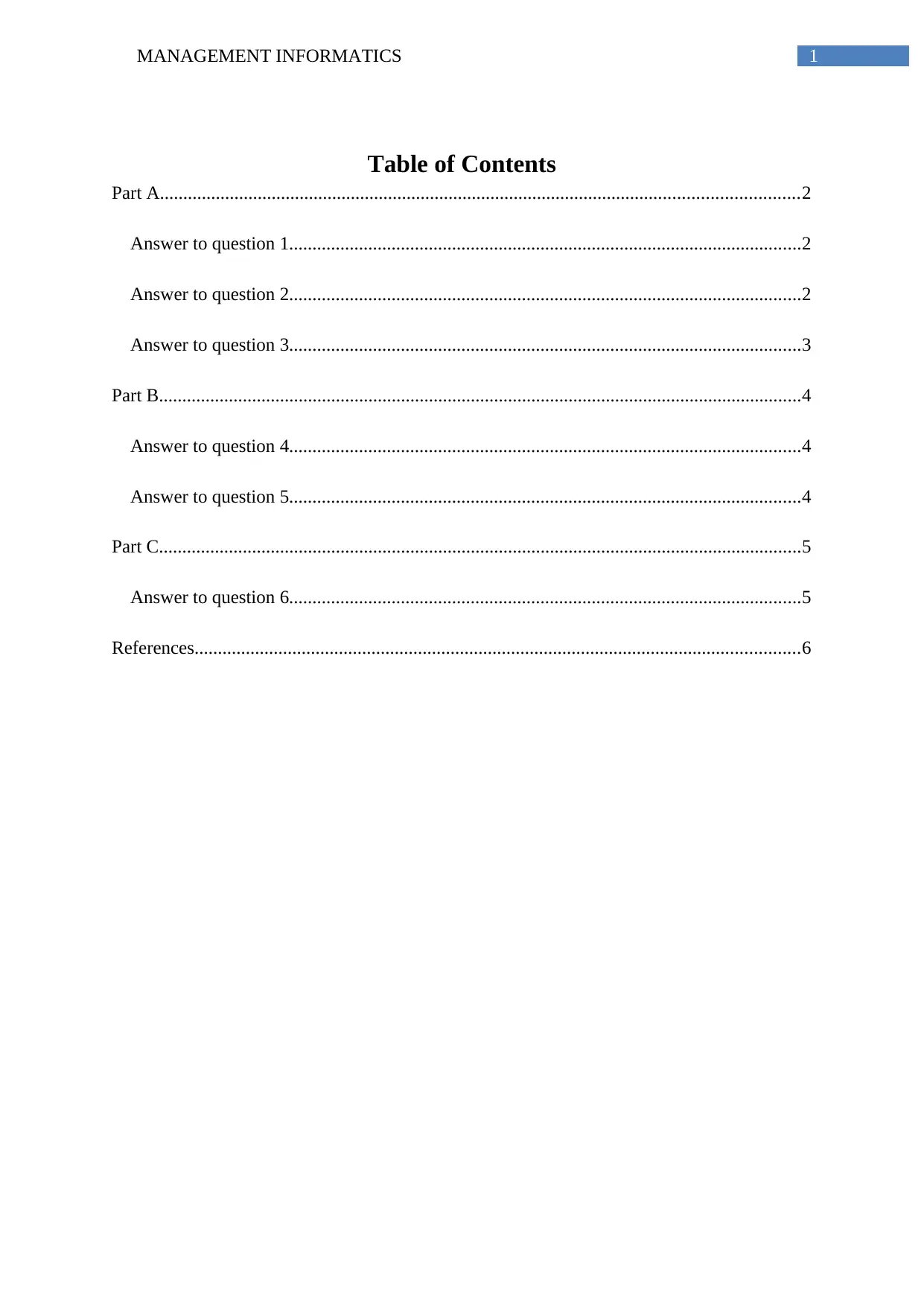
1MANAGEMENT INFORMATICS
Table of Contents
Part A.........................................................................................................................................2
Answer to question 1..............................................................................................................2
Answer to question 2..............................................................................................................2
Answer to question 3..............................................................................................................3
Part B..........................................................................................................................................4
Answer to question 4..............................................................................................................4
Answer to question 5..............................................................................................................4
Part C..........................................................................................................................................5
Answer to question 6..............................................................................................................5
References..................................................................................................................................6
Table of Contents
Part A.........................................................................................................................................2
Answer to question 1..............................................................................................................2
Answer to question 2..............................................................................................................2
Answer to question 3..............................................................................................................3
Part B..........................................................................................................................................4
Answer to question 4..............................................................................................................4
Answer to question 5..............................................................................................................4
Part C..........................................................................................................................................5
Answer to question 6..............................................................................................................5
References..................................................................................................................................6
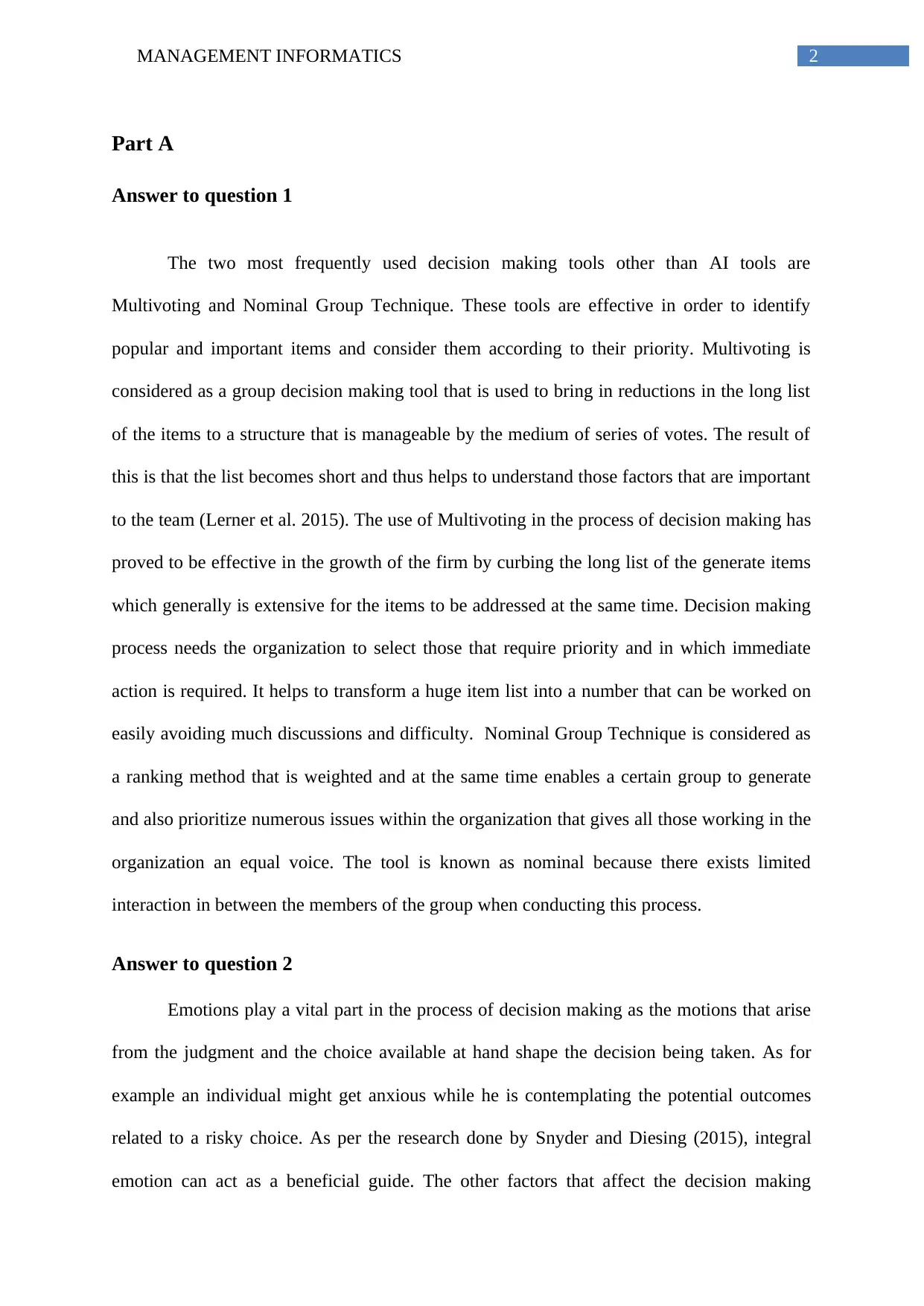
2MANAGEMENT INFORMATICS
Part A
Answer to question 1
The two most frequently used decision making tools other than AI tools are
Multivoting and Nominal Group Technique. These tools are effective in order to identify
popular and important items and consider them according to their priority. Multivoting is
considered as a group decision making tool that is used to bring in reductions in the long list
of the items to a structure that is manageable by the medium of series of votes. The result of
this is that the list becomes short and thus helps to understand those factors that are important
to the team (Lerner et al. 2015). The use of Multivoting in the process of decision making has
proved to be effective in the growth of the firm by curbing the long list of the generate items
which generally is extensive for the items to be addressed at the same time. Decision making
process needs the organization to select those that require priority and in which immediate
action is required. It helps to transform a huge item list into a number that can be worked on
easily avoiding much discussions and difficulty. Nominal Group Technique is considered as
a ranking method that is weighted and at the same time enables a certain group to generate
and also prioritize numerous issues within the organization that gives all those working in the
organization an equal voice. The tool is known as nominal because there exists limited
interaction in between the members of the group when conducting this process.
Answer to question 2
Emotions play a vital part in the process of decision making as the motions that arise
from the judgment and the choice available at hand shape the decision being taken. As for
example an individual might get anxious while he is contemplating the potential outcomes
related to a risky choice. As per the research done by Snyder and Diesing (2015), integral
emotion can act as a beneficial guide. The other factors that affect the decision making
Part A
Answer to question 1
The two most frequently used decision making tools other than AI tools are
Multivoting and Nominal Group Technique. These tools are effective in order to identify
popular and important items and consider them according to their priority. Multivoting is
considered as a group decision making tool that is used to bring in reductions in the long list
of the items to a structure that is manageable by the medium of series of votes. The result of
this is that the list becomes short and thus helps to understand those factors that are important
to the team (Lerner et al. 2015). The use of Multivoting in the process of decision making has
proved to be effective in the growth of the firm by curbing the long list of the generate items
which generally is extensive for the items to be addressed at the same time. Decision making
process needs the organization to select those that require priority and in which immediate
action is required. It helps to transform a huge item list into a number that can be worked on
easily avoiding much discussions and difficulty. Nominal Group Technique is considered as
a ranking method that is weighted and at the same time enables a certain group to generate
and also prioritize numerous issues within the organization that gives all those working in the
organization an equal voice. The tool is known as nominal because there exists limited
interaction in between the members of the group when conducting this process.
Answer to question 2
Emotions play a vital part in the process of decision making as the motions that arise
from the judgment and the choice available at hand shape the decision being taken. As for
example an individual might get anxious while he is contemplating the potential outcomes
related to a risky choice. As per the research done by Snyder and Diesing (2015), integral
emotion can act as a beneficial guide. The other factors that affect the decision making
⊘ This is a preview!⊘
Do you want full access?
Subscribe today to unlock all pages.

Trusted by 1+ million students worldwide
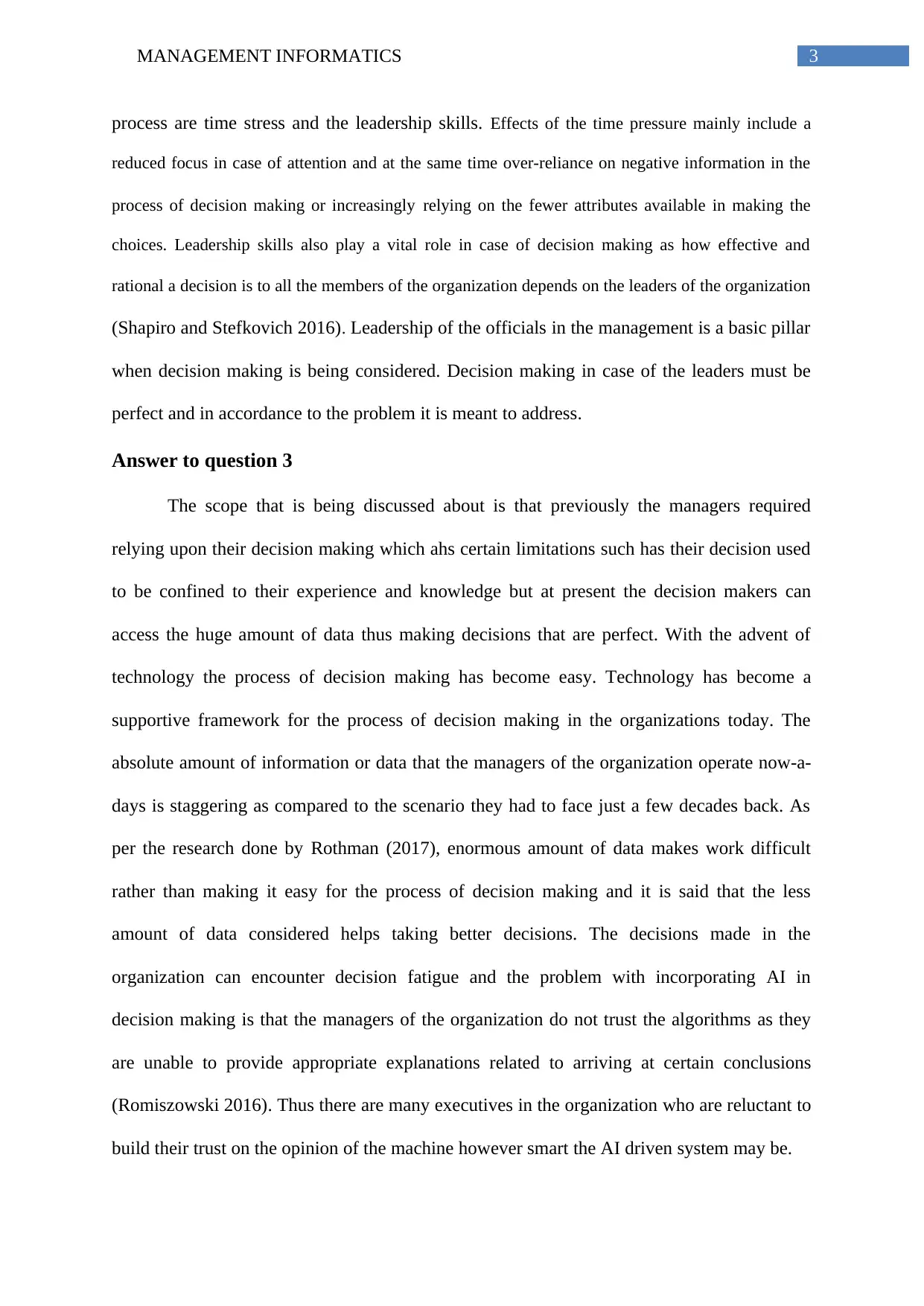
3MANAGEMENT INFORMATICS
process are time stress and the leadership skills. Effects of the time pressure mainly include a
reduced focus in case of attention and at the same time over-reliance on negative information in the
process of decision making or increasingly relying on the fewer attributes available in making the
choices. Leadership skills also play a vital role in case of decision making as how effective and
rational a decision is to all the members of the organization depends on the leaders of the organization
(Shapiro and Stefkovich 2016). Leadership of the officials in the management is a basic pillar
when decision making is being considered. Decision making in case of the leaders must be
perfect and in accordance to the problem it is meant to address.
Answer to question 3
The scope that is being discussed about is that previously the managers required
relying upon their decision making which ahs certain limitations such has their decision used
to be confined to their experience and knowledge but at present the decision makers can
access the huge amount of data thus making decisions that are perfect. With the advent of
technology the process of decision making has become easy. Technology has become a
supportive framework for the process of decision making in the organizations today. The
absolute amount of information or data that the managers of the organization operate now-a-
days is staggering as compared to the scenario they had to face just a few decades back. As
per the research done by Rothman (2017), enormous amount of data makes work difficult
rather than making it easy for the process of decision making and it is said that the less
amount of data considered helps taking better decisions. The decisions made in the
organization can encounter decision fatigue and the problem with incorporating AI in
decision making is that the managers of the organization do not trust the algorithms as they
are unable to provide appropriate explanations related to arriving at certain conclusions
(Romiszowski 2016). Thus there are many executives in the organization who are reluctant to
build their trust on the opinion of the machine however smart the AI driven system may be.
process are time stress and the leadership skills. Effects of the time pressure mainly include a
reduced focus in case of attention and at the same time over-reliance on negative information in the
process of decision making or increasingly relying on the fewer attributes available in making the
choices. Leadership skills also play a vital role in case of decision making as how effective and
rational a decision is to all the members of the organization depends on the leaders of the organization
(Shapiro and Stefkovich 2016). Leadership of the officials in the management is a basic pillar
when decision making is being considered. Decision making in case of the leaders must be
perfect and in accordance to the problem it is meant to address.
Answer to question 3
The scope that is being discussed about is that previously the managers required
relying upon their decision making which ahs certain limitations such has their decision used
to be confined to their experience and knowledge but at present the decision makers can
access the huge amount of data thus making decisions that are perfect. With the advent of
technology the process of decision making has become easy. Technology has become a
supportive framework for the process of decision making in the organizations today. The
absolute amount of information or data that the managers of the organization operate now-a-
days is staggering as compared to the scenario they had to face just a few decades back. As
per the research done by Rothman (2017), enormous amount of data makes work difficult
rather than making it easy for the process of decision making and it is said that the less
amount of data considered helps taking better decisions. The decisions made in the
organization can encounter decision fatigue and the problem with incorporating AI in
decision making is that the managers of the organization do not trust the algorithms as they
are unable to provide appropriate explanations related to arriving at certain conclusions
(Romiszowski 2016). Thus there are many executives in the organization who are reluctant to
build their trust on the opinion of the machine however smart the AI driven system may be.
Paraphrase This Document
Need a fresh take? Get an instant paraphrase of this document with our AI Paraphraser
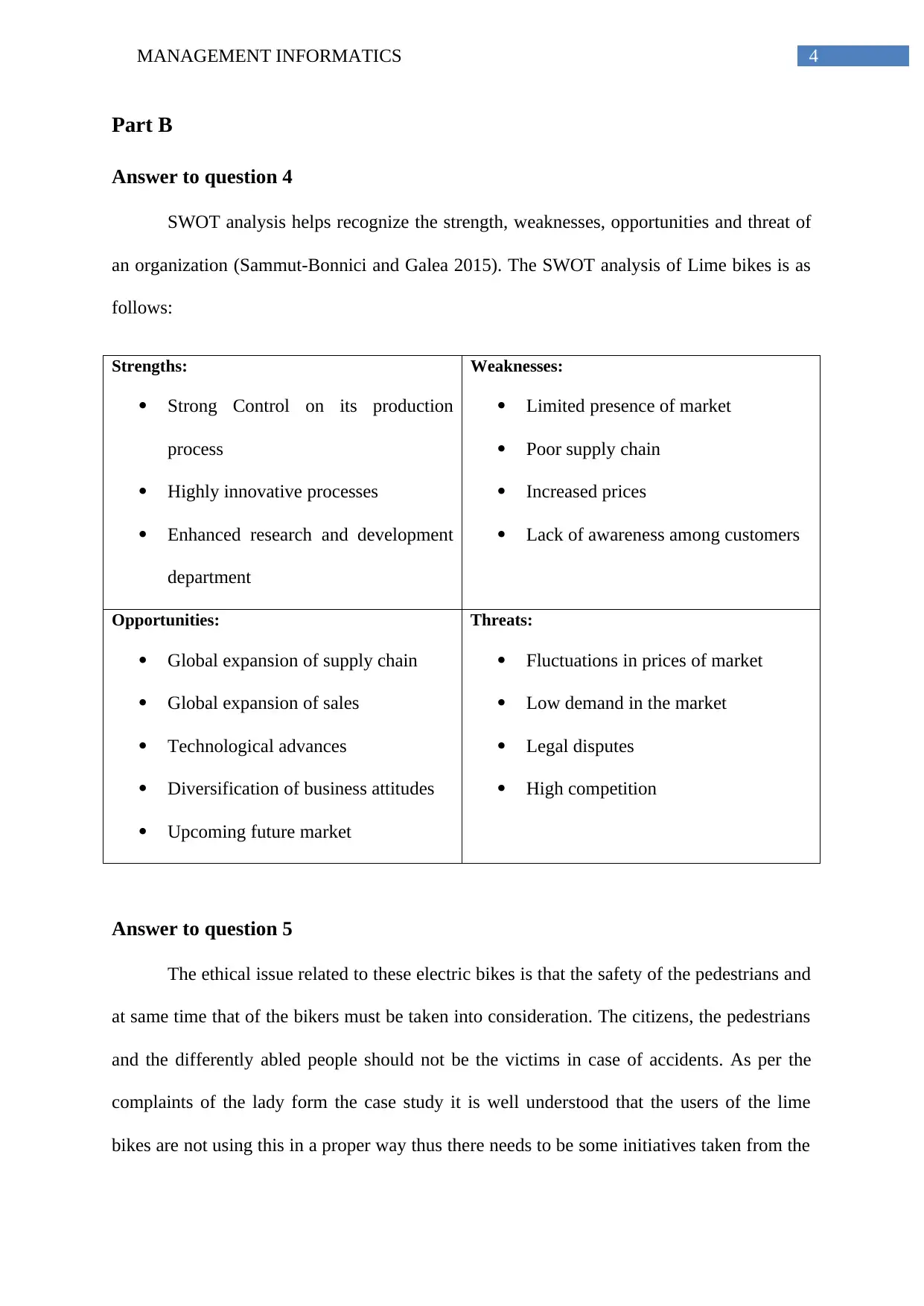
4MANAGEMENT INFORMATICS
Part B
Answer to question 4
SWOT analysis helps recognize the strength, weaknesses, opportunities and threat of
an organization (Sammut‐Bonnici and Galea 2015). The SWOT analysis of Lime bikes is as
follows:
Strengths:
Strong Control on its production
process
Highly innovative processes
Enhanced research and development
department
Weaknesses:
Limited presence of market
Poor supply chain
Increased prices
Lack of awareness among customers
Opportunities:
Global expansion of supply chain
Global expansion of sales
Technological advances
Diversification of business attitudes
Upcoming future market
Threats:
Fluctuations in prices of market
Low demand in the market
Legal disputes
High competition
Answer to question 5
The ethical issue related to these electric bikes is that the safety of the pedestrians and
at same time that of the bikers must be taken into consideration. The citizens, the pedestrians
and the differently abled people should not be the victims in case of accidents. As per the
complaints of the lady form the case study it is well understood that the users of the lime
bikes are not using this in a proper way thus there needs to be some initiatives taken from the
Part B
Answer to question 4
SWOT analysis helps recognize the strength, weaknesses, opportunities and threat of
an organization (Sammut‐Bonnici and Galea 2015). The SWOT analysis of Lime bikes is as
follows:
Strengths:
Strong Control on its production
process
Highly innovative processes
Enhanced research and development
department
Weaknesses:
Limited presence of market
Poor supply chain
Increased prices
Lack of awareness among customers
Opportunities:
Global expansion of supply chain
Global expansion of sales
Technological advances
Diversification of business attitudes
Upcoming future market
Threats:
Fluctuations in prices of market
Low demand in the market
Legal disputes
High competition
Answer to question 5
The ethical issue related to these electric bikes is that the safety of the pedestrians and
at same time that of the bikers must be taken into consideration. The citizens, the pedestrians
and the differently abled people should not be the victims in case of accidents. As per the
complaints of the lady form the case study it is well understood that the users of the lime
bikes are not using this in a proper way thus there needs to be some initiatives taken from the

5MANAGEMENT INFORMATICS
company that could assist the user in using the bikes and at the same time some restrictions
imposed on parking the bikes (Yin, Qian and Singhapakdi 2018). The complaints from the
visually impaired pedestrians should be given importance and the issues relating to the bells
or the auditory signals in the scooter must be resolved. The riders of these particular scooters
should be advised to drive in a proper way and the cases of overtaking and rash driving must
be analyzed and solutions made accordingly (Stelling-Konczak et al. 2018). When it comes to
ethics then the government, the authorities of the lime bikes company as well as the users
come into play. All of them have some responsibilities in this case as with the usage and the
advantages of technologies comes in certain duties and responsibilities that should be
understood and done.
Part C
Answer to question 6
The above statement signifies the exceeding usage of computer in every field that
exists. The advancements in technology have been so significant that in the present world,
every single work is associated with a technological support. Rather without technology
nothing would have been possible. Recently smart lights, smart ACs and smart security
system are some of the instances that are used as equipments of smart household. Smart lights
can be simply switched off and on with the help of a smartphones and the official application
of the company (Van Deursen and Helsper 2015). Smart ACs can be controlled by same
manner even if the person is somewhere outside by making the two devices connected to a
network. Smart security system lets one check about the happenings around the individual’s
house even if the person is somewhere outside. As all of the devices are digital hence any
faults cannot be repaired by regular means and have to be consulted to an IT professional. In
case of the security system, the entire system can be hacked and one can simply take an
company that could assist the user in using the bikes and at the same time some restrictions
imposed on parking the bikes (Yin, Qian and Singhapakdi 2018). The complaints from the
visually impaired pedestrians should be given importance and the issues relating to the bells
or the auditory signals in the scooter must be resolved. The riders of these particular scooters
should be advised to drive in a proper way and the cases of overtaking and rash driving must
be analyzed and solutions made accordingly (Stelling-Konczak et al. 2018). When it comes to
ethics then the government, the authorities of the lime bikes company as well as the users
come into play. All of them have some responsibilities in this case as with the usage and the
advantages of technologies comes in certain duties and responsibilities that should be
understood and done.
Part C
Answer to question 6
The above statement signifies the exceeding usage of computer in every field that
exists. The advancements in technology have been so significant that in the present world,
every single work is associated with a technological support. Rather without technology
nothing would have been possible. Recently smart lights, smart ACs and smart security
system are some of the instances that are used as equipments of smart household. Smart lights
can be simply switched off and on with the help of a smartphones and the official application
of the company (Van Deursen and Helsper 2015). Smart ACs can be controlled by same
manner even if the person is somewhere outside by making the two devices connected to a
network. Smart security system lets one check about the happenings around the individual’s
house even if the person is somewhere outside. As all of the devices are digital hence any
faults cannot be repaired by regular means and have to be consulted to an IT professional. In
case of the security system, the entire system can be hacked and one can simply take an
⊘ This is a preview!⊘
Do you want full access?
Subscribe today to unlock all pages.

Trusted by 1+ million students worldwide

6MANAGEMENT INFORMATICS
unauthorised access to the premises and can serve for own benefits. The smart devices can be
difficult to operate for a person with little knowledge about technology.
unauthorised access to the premises and can serve for own benefits. The smart devices can be
difficult to operate for a person with little knowledge about technology.
Paraphrase This Document
Need a fresh take? Get an instant paraphrase of this document with our AI Paraphraser
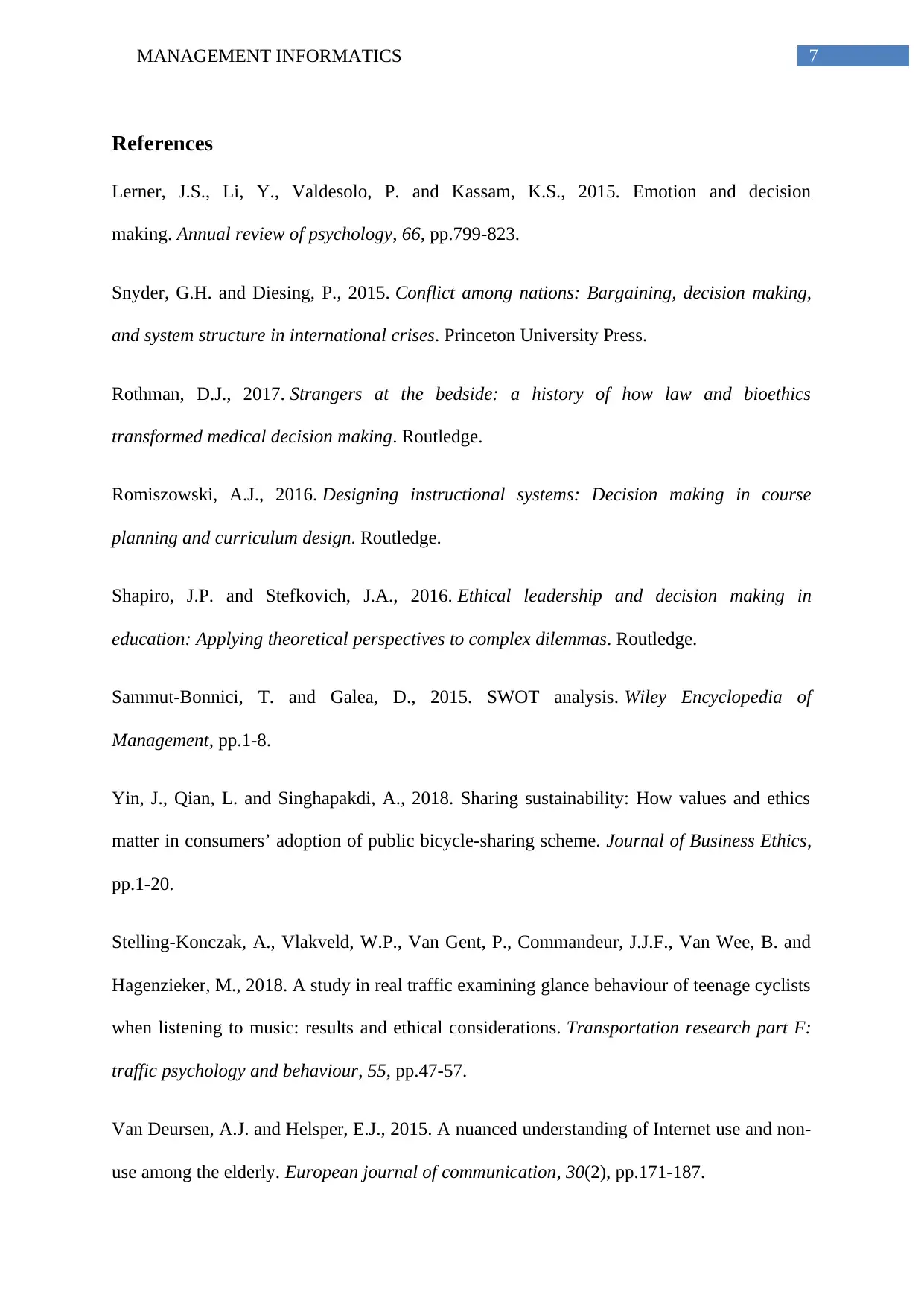
7MANAGEMENT INFORMATICS
References
Lerner, J.S., Li, Y., Valdesolo, P. and Kassam, K.S., 2015. Emotion and decision
making. Annual review of psychology, 66, pp.799-823.
Snyder, G.H. and Diesing, P., 2015. Conflict among nations: Bargaining, decision making,
and system structure in international crises. Princeton University Press.
Rothman, D.J., 2017. Strangers at the bedside: a history of how law and bioethics
transformed medical decision making. Routledge.
Romiszowski, A.J., 2016. Designing instructional systems: Decision making in course
planning and curriculum design. Routledge.
Shapiro, J.P. and Stefkovich, J.A., 2016. Ethical leadership and decision making in
education: Applying theoretical perspectives to complex dilemmas. Routledge.
Sammut‐Bonnici, T. and Galea, D., 2015. SWOT analysis. Wiley Encyclopedia of
Management, pp.1-8.
Yin, J., Qian, L. and Singhapakdi, A., 2018. Sharing sustainability: How values and ethics
matter in consumers’ adoption of public bicycle-sharing scheme. Journal of Business Ethics,
pp.1-20.
Stelling-Konczak, A., Vlakveld, W.P., Van Gent, P., Commandeur, J.J.F., Van Wee, B. and
Hagenzieker, M., 2018. A study in real traffic examining glance behaviour of teenage cyclists
when listening to music: results and ethical considerations. Transportation research part F:
traffic psychology and behaviour, 55, pp.47-57.
Van Deursen, A.J. and Helsper, E.J., 2015. A nuanced understanding of Internet use and non-
use among the elderly. European journal of communication, 30(2), pp.171-187.
References
Lerner, J.S., Li, Y., Valdesolo, P. and Kassam, K.S., 2015. Emotion and decision
making. Annual review of psychology, 66, pp.799-823.
Snyder, G.H. and Diesing, P., 2015. Conflict among nations: Bargaining, decision making,
and system structure in international crises. Princeton University Press.
Rothman, D.J., 2017. Strangers at the bedside: a history of how law and bioethics
transformed medical decision making. Routledge.
Romiszowski, A.J., 2016. Designing instructional systems: Decision making in course
planning and curriculum design. Routledge.
Shapiro, J.P. and Stefkovich, J.A., 2016. Ethical leadership and decision making in
education: Applying theoretical perspectives to complex dilemmas. Routledge.
Sammut‐Bonnici, T. and Galea, D., 2015. SWOT analysis. Wiley Encyclopedia of
Management, pp.1-8.
Yin, J., Qian, L. and Singhapakdi, A., 2018. Sharing sustainability: How values and ethics
matter in consumers’ adoption of public bicycle-sharing scheme. Journal of Business Ethics,
pp.1-20.
Stelling-Konczak, A., Vlakveld, W.P., Van Gent, P., Commandeur, J.J.F., Van Wee, B. and
Hagenzieker, M., 2018. A study in real traffic examining glance behaviour of teenage cyclists
when listening to music: results and ethical considerations. Transportation research part F:
traffic psychology and behaviour, 55, pp.47-57.
Van Deursen, A.J. and Helsper, E.J., 2015. A nuanced understanding of Internet use and non-
use among the elderly. European journal of communication, 30(2), pp.171-187.
1 out of 8
Related Documents
Your All-in-One AI-Powered Toolkit for Academic Success.
+13062052269
info@desklib.com
Available 24*7 on WhatsApp / Email
![[object Object]](/_next/static/media/star-bottom.7253800d.svg)
Unlock your academic potential
Copyright © 2020–2025 A2Z Services. All Rights Reserved. Developed and managed by ZUCOL.





